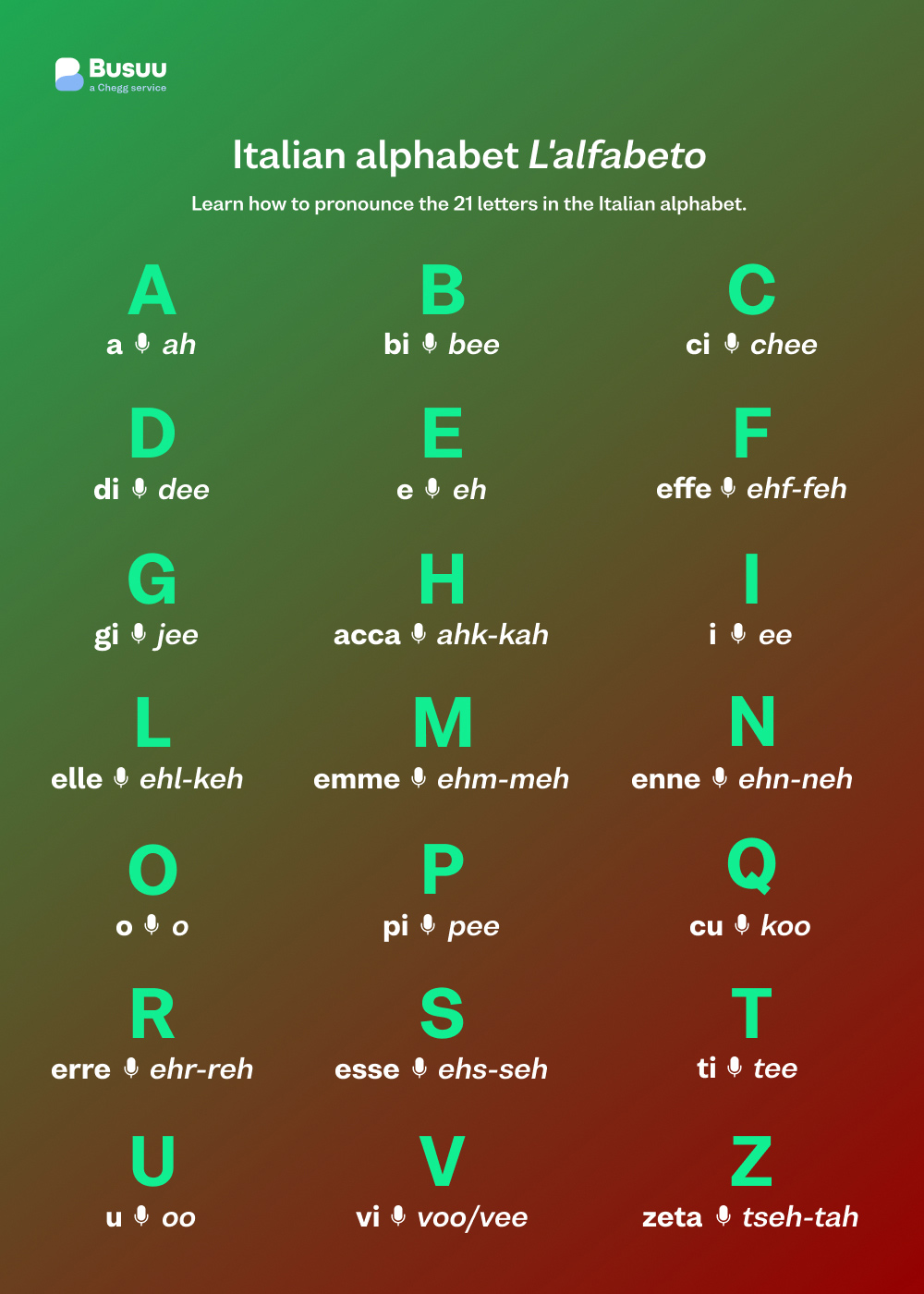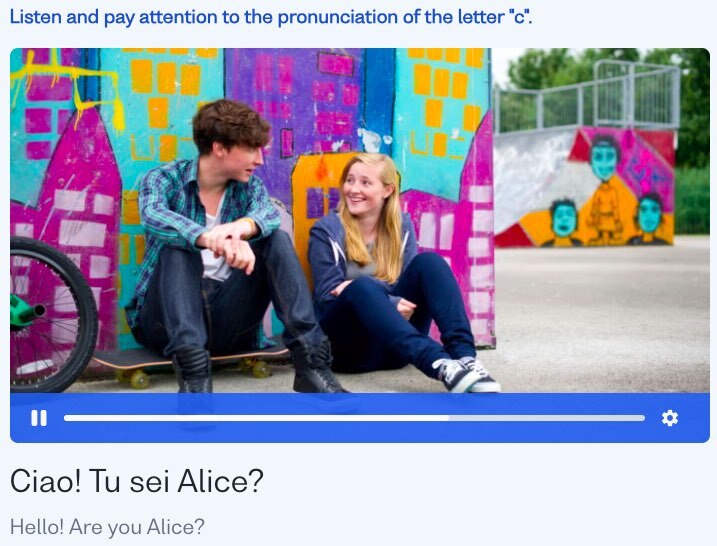Speak a language in
10 minutes a dayTM
If the Italian language is music to your ears, think of the Italian alphabet letters as the musical notes. Italian is beautiful to hear and fun to speak – and the good news for Italian learners is that it’s also easy to pronounce.
This is because Italian is a very phonetic language – which means that most of the time, you’ll pronounce words correctly on the first attempt. The Italian alphabet pronunciation is very consistent with just a few exceptions.
Unlike French or English, there are very few silent letters in Italian. When in doubt, sound out each letter or letter combination.
Pronto? Ready to begin?
The most common questions about the Italian alphabet, answered
How do you read ABC in Italian?
The letters for ABC in Italian are A (a), B (bi) and C (ci). For pronunciation help and the full Italian phonetic alphabet list, check out the table below.
Does Italian only have 21 letters?
Italian comes from Latin and uses a modern form of the Latin alphabet, with just 21 letters.
What are the 5 letters missing in the Italian alphabet?
Five English letters don’t exist in Italian: J, K, W, X and Y. Though interestingly, you will still see these missing letters in a few specific instances, such as in foreign words, acronyms, company names and number plates on cars.
What is J in Italian?
Though there isn’t a letter J in Italian, the letter G (gi) makes the soft G or J sound in English – think of the soft gi sound in the name Luigi, or the soft ge sound in the delectable dessert, gelato.
So how do you know when it’s a hard G sound or a soft G/J sound? It depends on the vowel following the G:
- Pronouncing the hard G sound: Whenever you see ga-, go-, gu-, ghi- or _ghe-, you pronounce the word with a hard G like the English “gate”. Examples of this are spaghetti or gusto.
- Pronouncing the soft G/J sound: Words with the letter combinations gi- and ge- in Italian use a soft G or J sound, like “jelly” or “jug”. Examples to help you remember this are giraffa (giraffe), or the example we can’t get enough of, gelato – Italy’s most delicious frozen treat.

Introducing the Italian alphabet and its pronunciation
| Letter | Name | In Action |
|---|---|---|
| A | a (ah) | anello (ring) |
| B | bi (bee) | banana (banana) |
| C | ci (chee) | cena (dinner) |
| D | di (dee) | donna (woman) |
| E | e (eh) | energia (energy) |
| F | effe (ehf-feh) | formaggio (cheese) |
| G | gi (jee) | gatto/gatta (cat) |
| H | acca (ahk-kah) | hotel (hotel) |
| I | i (ee) | italiano (Italian) |
| L | elle (ehl-keh) | latte (milk) |
| M | emme (ehm-meh) | medico (doctor) |
| N | enne (ehn-neh) | negozio (store) |
| O | o (o) | orologio (clock) |
| P | pi (pee) | pesce (fish) |
| Q | cu (koo) | quando (when) |
| R | erre (ehr-reh) | respirare (breathe/breather) |
| S | esse (ehs-seh) | studente/studentessa (student) |
| T | ti (tee) | torta (cake) |
| U | u (oo) | uccello (bird) |
| V | vi (voo/vee) | vino (wine) |
| Z | zeta (tseh-tah) | zero (zero) |
Italian pronunciation: 3 common mistakes to avoid
1. Double consonants
Italian is full of words like nonna (granny), doppio (double), and caffè (coffee) with double consonants. You can hear the difference between double and single consonants in spoken Italian – for double consonants, exaggerate and draw out the sounds to pronounce it correctly. If you don’t, meaning might be lost. For instance, you wouldn’t want to say you wanted to go to the cassa (cash desk) when you meant the casa (house)!
2. How to pronounce C in Italian
Like G, C is a tricky letter for Italian learners because it can have several different sounds.
K sound
C in Italian makes a hard K sound like “car” when paired with ca-, co-, cu-, che- or chi-. One example of this is cane (dog), pronounced kah-neh.
Ch sound
Like G, C is changed when paired with ci- or ce- to make the sound “ch” like “charge". An example of this is ciao, Italy’s famous greeting, pronounced “chow".
3. Vowels in Italian
If you only take away one thing from this article, take away this: learn your Italian vowels.
The letter Y in Italian doesn’t exist, so the five classic vowels—A, E, I, O, and U—do all the work.
Vowel sounds make up the foundation of the Italian language – and when you see one at the end of a word, it’ll tell you whether a word is masculine or feminine, and singular or plural. Respect the language and avoid confusion with precise vowel sounds!
Here are couple of things to look out for:
- English speakers may be tempted to drop an E sound (like in “elephant”) at the end of a word like the silent E in English – but you should always sound out the E in Italian.
- Make sure to pronounce E with “EH” as in “beg” or instead of “AY” as in “play”.
Now that you’ve got the hang of the Italian phonetic alphabet, you can read any Italian word – even if you don’t know its meaning!
Buona fortuna! (Good luck!)
Hungry for more Italiano?
Join Busuu and get access to free online courses and learning resources designed by Italian language experts! Learn with fellow Italian language learners and native speakers in a big community that teaches you how to speak up!

